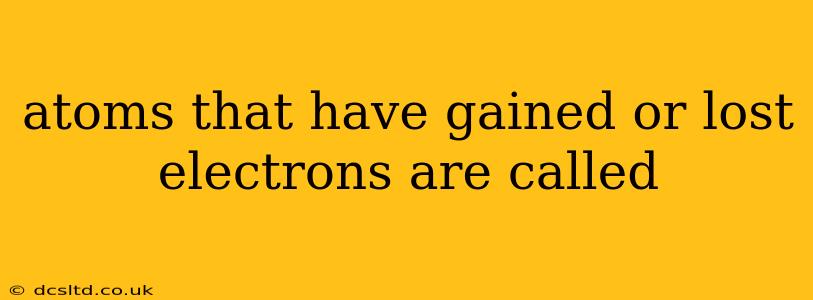Atoms are the fundamental building blocks of matter, but their behavior and properties can dramatically change depending on their electron configuration. When an atom gains or loses electrons, it no longer has a neutral charge, transforming into what's known as an ion. Understanding ions is crucial for comprehending a vast range of chemical and physical processes. This article will delve into the world of ions, explaining their formation, properties, and significance.
What are Ions?
An ion is an atom or molecule that carries an electric charge. This charge arises from an imbalance in the number of protons (positively charged particles) and electrons (negatively charged particles). Unlike neutral atoms where the number of protons and electrons are equal, ions possess a net positive or negative charge.
-
Cations: When an atom loses one or more electrons, it becomes positively charged because it now has more protons than electrons. These positively charged ions are called cations. Metals tend to form cations. For example, sodium (Na) readily loses one electron to become a sodium cation (Na⁺).
-
Anions: Conversely, when an atom gains one or more electrons, it becomes negatively charged due to having more electrons than protons. These negatively charged ions are called anions. Nonmetals frequently form anions. For instance, chlorine (Cl) readily gains one electron to become a chloride anion (Cl⁻).
How are Ions Formed?
Ion formation, also known as ionization, typically occurs through the transfer of electrons between atoms. This transfer is driven by the desire of atoms to achieve a stable electron configuration, often resembling that of a noble gas (Group 18 elements). This stable configuration is usually characterized by a full outer electron shell.
For example, sodium (Na) has one electron in its outermost shell. It readily loses this electron to achieve a stable configuration similar to neon (Ne). Chlorine (Cl), on the other hand, has seven electrons in its outermost shell and readily gains one electron to achieve a stable configuration similar to argon (Ar). The electron lost by sodium is gained by chlorine, resulting in the formation of Na⁺ and Cl⁻ ions. This electrostatic attraction between the oppositely charged ions forms an ionic bond, leading to the formation of sodium chloride (NaCl), commonly known as table salt.
Why are Ions Important?
Ions play a vital role in various processes:
-
Chemical Reactions: Many chemical reactions involve the formation and interaction of ions. Ionic compounds are formed through the electrostatic attraction between oppositely charged ions.
-
Biological Processes: Ions are essential for biological functions. For example, sodium (Na⁺), potassium (K⁺), calcium (Ca²⁺), and chloride (Cl⁻) ions are crucial for nerve impulse transmission, muscle contraction, and maintaining fluid balance in the body.
-
Electrochemistry: Ions are the carriers of charge in electrochemical processes like batteries and electroplating.
-
Material Science: The properties of many materials are strongly influenced by the presence of ions.
What are some examples of ions?
Numerous ions exist, both simple and complex. Here are some common examples:
- Sodium ion (Na⁺): A cation found in table salt and crucial for nerve function.
- Chloride ion (Cl⁻): An anion found in table salt and essential for fluid balance.
- Calcium ion (Ca²⁺): A cation vital for bone structure and muscle function.
- Sulfate ion (SO₄²⁻): A polyatomic anion found in many minerals and acids.
- Ammonium ion (NH₄⁺): A polyatomic cation found in fertilizers and some cleaning agents.
What is the difference between an ion and an atom?
The key difference lies in the charge. An atom has an equal number of protons and electrons, resulting in a neutral charge. An ion, however, has an unequal number of protons and electrons, leading to a net positive (cation) or negative (anion) charge.
How are ions detected?
Ions can be detected using various techniques, including:
- Mass spectrometry: This technique separates ions based on their mass-to-charge ratio.
- Spectroscopy: This technique analyzes the interaction of ions with electromagnetic radiation.
- Conductivity measurements: Ionic solutions conduct electricity because of the movement of ions.
In conclusion, ions are charged atoms or molecules that play a fundamental role in chemistry, biology, and other scientific disciplines. Understanding their formation, properties, and importance is key to grasping a wide range of natural phenomena and technological applications.
